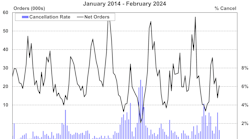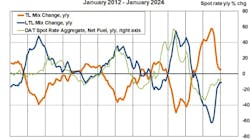The Trucking Conditions Index (TCI) metric crafted by industry research firm FTR dropped nearly 50% in March from February to 4.22 and is now at its lowest level since 2011.
FTR added that truck freight loadings and the freight market in general is now consistent with a “slow growth” environment, with further declines possible due to the overall weak economic environment.
However the firm did stress in a statement that regulations – such as the impending electronic logging device (ELD) mandated – should reduce trucking productivity thus could move the TCI higher in 2017 and 2018, as capacity becomes constrained.
“The freight markets have slowed significantly over the last year with March volumes just 1.5% above year ago levels. On a seasonally-adjusted basis, volumes were lower in March than what was seen in July of last year,” noted Jonathan Starks, FTR’s COO, in a statement. “The market has essentially moved sideways for more than half a year.”
He added, however, that the “good news” is that manufacturing looks to be growing again, while consumers haven’t stopped spending.
“The bad news is that manufacturing output will remain weak during most of 2016, and consumer spending hasn’t grown strong enough to make up the difference,” Starks pointed out. “Add in the serious inventory glut that has persisted since early 2015 and there is little to call for a significant change in the carriers operating environment for 2016.”
One surprise, though, is the “sharply negative environment” for contract rates in early 2016, said Starks.
“This has occurred at the same time that spot market rates have finally stabilized,” he noted. “I believe it is a delayed response to the 2015 easing of capacity combined with rising fuel prices that has hurt the contract market this year. Weak rate growth will persist but not at the negative level that we are currently seeing, especially once we hit 2017 and the regulatory pressures begin to increase.”








